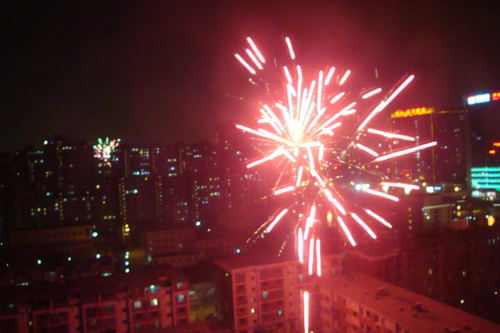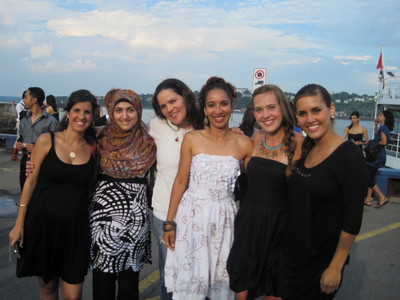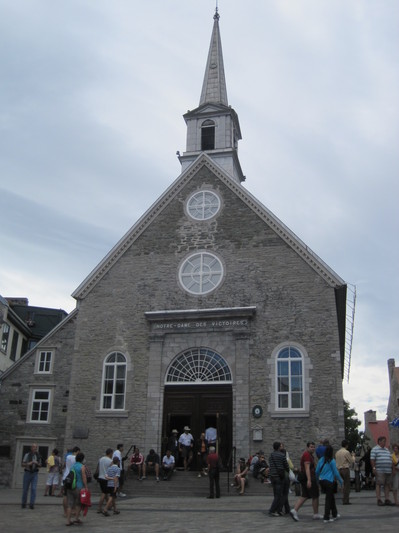Arrival and Start of Orientation!
So once everyone arrived on Monday, we all realized that our rooms were organized by first name, so I was in a room with two girls named Hannah! At first we thought it was a coincidence but then the room of Emilys and the room of Ashleys, and the room of Amandas assured us otherwise.
Dinner was great, there were lots of fresh veggies and fruit, and some meat, which looked good – for those who would eat it.
After eating, everyone took some time to primp and then split up and go out for drinks and to walk around. I ended up with girls from the room of Ashleys and a bunch of kids from Penn State, so it was fun to sit around and talk Happy Valley with some new and some familiar faces. A few of us that had Spanish 3 together freshman year are planning to go to Ronda, where our professor for that class was from, at some point in the semester. Ronda is unique for its beautiful landscape of cliffs and mountains, many peoples’ homes are carved right into caves and the sides of cliffs! Worth the trip, and in your case, checking out some photos 😉
Another Long and Busy Day
Breakfast yesterday, which I’d missed the day before, was great! There were cheeses and prunes, olives, tomatoes with mozzarella and pesto, and a variety of hot dishes that I decided against when I saw all the fresh fruit! Our “guia,” or guide, Carmen, told us that this was not very traditional breakfast food, and more typical of a hotel than a morning spread at home.
During orientation they reiterated a lot of things that we’d read or heard about prior, but some things were new. Things like warnings about the fact that everyone wears slippers in the house because most homes (apartments, in our cases) have tile floors that get very cold in the winter. We finally found out about our homestays, most of which were with families. Mine was with a woman and her elderly mother in an area called Triana, where I would live within blocks of all of the girls from my orientation group, and walking distance across the bridge from the university. We also had some information sessions about our classes and homestays, between which (and through the start of the latter of the two) I slept because I was soo exhausted from the constant activity. The same was true today between breakfast and our check out at noon, probably because we had such a late night last night. We left the hotel after a short “descanso” (break), and headed for a flamenco show in town. The area we went to is called Barrio (neighborhood) de Santa Cruz, and used to be inhabited by the Jewish population of Sevilla. Now, there are some remnants of their presence, but mostly in the form of galleries and small pieces of Judaica in little glass cases. I saw one such case in La Casa de la Memoria de Al-Andalus (clearly more recently Moroccan-influenced), which was neat because everything else here is of very intensely Catholic, and/or Moorish roots – like the Catedral, which is a breathtaking mix of the two.
The flamenco itself was incredible. About 90 of us sat squeezed into a high-ceilinged room with a wide banner of ornate tile all the way around. There were old deep red brick-tile floors where the concrete underneath was partially exposed in one small spot from the continuous stomping of heels to a traditionally Spanish beat. After a routine, but comical advisory not to use cameras until the end, and that smoking and videos were prohibited, the show began. First, two men entered the room and sat in two chairs on the small stage. One played guitar while the other clapped, tapped his feet, and sang. Next they moved off to sit behind the stage, and were joined by a dancer, who wowed the crowd with his sharp but flowing spins, stomps and turns. A woman eventually joined them to clap, and occasionally called out various phrases and words in time with the music. Later she danced while the male dancer did the same for her. It was when she was dancing that I remembered the profundity of the emotion behind this art. I was overcome with awe by the reality that flamenco begged of the dancer what I would expect to be a very deep emotional commitment, as well as a physical one. The man and woman then danced together, and made an abrupt exit before coming back in for a short encore and bows. That was when I started to truly feel like we were in Spain, when we saw this example of the dedication to the culture that has been so valued and well-preserved by its people.
After that, our half of the program (groups 1-9, 85 people + 9 guias), made our way down the street for tapas. We ate so much, I didn’t know how I would walk home afterwards. Piles of potatoes with ketchup and mayonnaise, various roasted veggie, meat, and seafood dishes, and some interesting things I’d never seen before. For example, fried salsa balls, which were bite-sized spheres of pink salsa that tasted like gespacho, bread battered and deep fried. We didn’t get home until almost 1am, at which point some people were ready to (and some did) go out, while others hung around the bar until the lights went out and we figured it would be best to get some sleep.
Moving into the Homestay.
This morning, we had to be up by 9 am for breakfast, and downstairs at 10:30 for orientation activities and Spanish “entrevistas” (interviews), to confirm our language placement. Between the two I took a much needed nap, and afterwards brought down my bags to prepare to leave the hotel and move into my homestay at 11:30. Upon meeting my se�ora, or host mother, we exchanged a kiss on each cheek (always starting with the left), made fun of how much stuff I had (along with the other 20 se�oras standing around us), and caught a taxi to Triana. When we first got there, my host mom introduced me to her daughter and talked with some friends, and then helped me schlep those two deadweight bags up the 3 flights of steps to the 3rd floor. This is another thing about Spain that continually confuses me, despite the fact that I was educated about it in high school: the numbering of the stories in a building. The ground floor is considered Planta 0 (referred to as the “Planta baja”); the one above that, the primera (“1a”) Planta; and what we would call the third floor is la segunda (“2a”) Planta, and so on. In North American counting, we live on the 4th floor, which I prefer, mostly because 4 is my lucky number 🙂
When we finally got all of my stuff in, my host mom asked if I wanted to go for a walk with her daughter and grandson. I wanted to see some of town, so this was a perfect opportunity to do so. We walked around with her new born baby, Ivan, in a stroller, talked about Spain, where she lives now (outside the city in a place called Alcal�), and soaked up the warm afternoon sun. Another thing we learned from Carmen – which I witnessed again on this walk – was that it is perfectly normal for people to take a break in the middle of the day for tapas and a beer. The streets are always full of people sitting or walking around, enjoying the company of one another and the day. I love this aspect of the culture, and think it’s a healthy way to interact, get exercise, and some fresh air.
We had our first meal at about 2:30. It was a plate of potatoes, garbanzos, spinach, and pinto beans that had been cooked with pork (my fears of misunderstanding “red meat” became as real as i’d anticipated they might). I had a little and simply explained that I include “cerdo” in the list of animals I don’t eat.
I had a quick Skype chat with my dad to update him on how things were going – it was nice to see him and hear his voice 🙂 My host mom then took me to meet up with my group at 4:15 in a plaza nearby. We walked from there to the university for more orientation meetings and info sessions. On the way, i realized that the main road between our neighborhood and the other side if the river, where we were headed, was Calle Betis! It’s one of the most popular strips of shops and tapas bars in town, which I’d heard about before I got here, and mentioned in a pre-trip post. Anyways, this time we walked into a large building where hundreds of students were studying for final exams, which are taking place in the next few weeks. After a grueling two hours of trying to keep our eyes open, and then waiting for who knows what, we found the guides that had been holding us up and made our way into town near the Catedral for tapas.
I went with two girls that I’ve been spending a lot of time with, Ronda and Hannah (Childs – who was my roommate at the hotel), to have some desert while everyone else had drinks at an outdoor bar with our guides afterwards. Ronda and I split a “postre” (dessert) de chocolate y galletas (chocolate and cookies – really more like “rich, soft, cream and choco-layer slice”) and each had coffee. This was delicious.
At last, Hannah and I made it into my apartment, when I realized that I had my address on my homestay assignment paper. She came in and I introduced her to everyone and then said goodnight. I just took my first shower in the apartment, which was great, considering the small quarters, relative to what I’m used to. I’ve already grown accustomed to asking to use anything that belongs to my host family, and using Spanish to communicate everything. I love Spain, and can’t wait to become better acquainted with my family and the area we live in 🙂
When do we eat? A cultural lesson.
Adjusting to the eating schedule has been a bit of the challenge, but I like that we have a lot of time between meals, it means we’re hungry when we eat and we really appreciate the food! Breakfast is what ever time you get up, lunch is some time between 1pm and 3pm (or even later some times), and dinner usually consists of tapas any time from 8:30pm to 10ish. Eating late has never really worked well for me, but it helps that we walk around so much and have the opportunity to digest that way.
Location: Triana. Sevilla, Spain.










